Related Research Articles

Gentiana andrewsii, the bottle gentian, closed gentian, or closed bottle gentian, is an herbaceous species of flowering plant in the gentian family Gentianaceae. Gentiana andrewsii is native to northeastern North America, from the Dakotas to the East Coast and through eastern Canada.
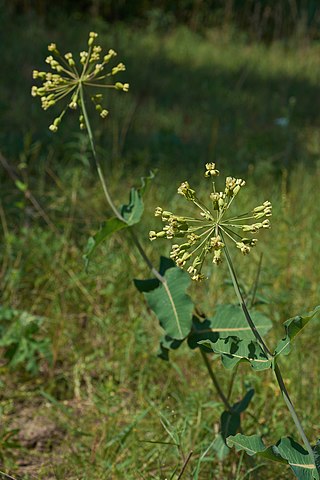
Asclepias amplexicaulis, the blunt-leaved milkweed, clasping milkweed, or sand milkweed, is a species of flowering plant in the subfamily Asclepiadoideae (Apocynaceae). It is endemic to the United States, where it is mostly found east of the Great Plains. It grows in dry prairies, savannas, open woods, and fallow fields, usually in sandy soil.

Primula meadia, known by the common names shooting star, eastern shooting star, American cowslip, roosterheads, and prairie pointers is a species of flowering plant in the primrose family Primulaceae. It is native to the eastern United States and Canada, spanning north from Manitoba and New York, south to Texas and Florida.
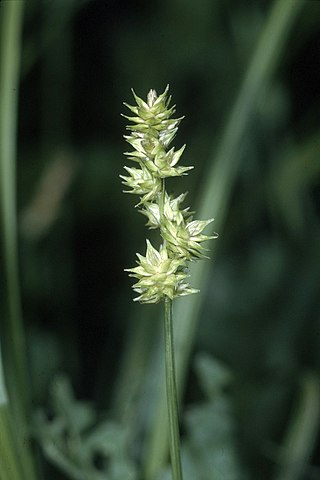
Carex sparganioides, known as bur-reed sedge or loose-headed bracted sedge, is a perennial plant belonging to the sedge family (Cyperaceae). Its native range includes most of the eastern and central United States and eastern Canada. In Maine, it is typically found in hardwood or mixed forests.

Trillium recurvatum, the prairie trillium, toadshade, or bloody butcher, is a species of perennial herbaceous flowering plant in the family Melanthiaceae. It is native to parts of central and eastern United States, where it is found from Iowa south to Texas and east to North Carolina and Pennsylvania. It grows in mesic forests and savannas, often in calcareous soils. It is also known as bloody noses, red trillium, prairie wake-robin, purple trillium, and reflexed trillium, in reference to its reflexed sepals.

Carex brunnescens, the brownish sedge or green bog sedge, is a species of plant in the sedge family (Cyperaceae). It has a circumboreal distribution, and is native to North America and Eurasia. In the United States it is primarily found in the Northeast and Midwest extending south into the Appalachian Mountains, with disjunct populations westward in the Rocky Mountains. It has a wide-ranging natural habitat, is in found in forests, bogs, fens, and rock outcrops.
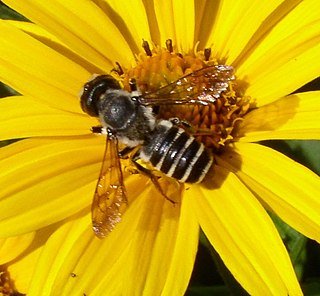
Megachile pugnata is a species of North American bee in the family Megachilidae. It was described by Thomas Say in 1837.
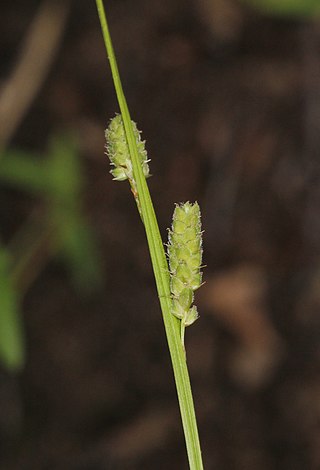
Carex swanii, known as Swan's sedge or downy green sedge, is a species of flowering plant in the family Cyperaceae. It is native to eastern North America.

Leucospora multifida, known variously as Obi-Wan conobea, narrow-leaved paleseed, cliff conobea, cut-leaved conobea, or much-cleft conobea, is an annual herb in the plantain family, Plantaginaceae, and the only species in the North American genus Leucospora.
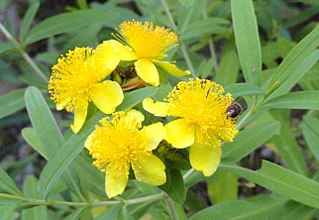
Hypericum kalmianum, commonly called Kalm's St. Johns wort or Kalm's St. Johnswort, is a flowering plant in the St. John's wort family Hypericaceae. It is native to the Great Lakes region in the northern United States and southern Canada. Hypericum kalmianum was named after its discoverer, Swedish botanist Pehr Kalm (1715-1779).
Floristic Quality Assessment (FQA) is a tool used to assess an area's ecological integrity based on its plant species composition. Floristic Quality Assessment was originally developed in order to assess the likelihood that impacts to an area "would be irreversible or irretrievable...to make standard comparisons among various open land areas, to set conservation priorities, and to monitor site management or restoration efforts." The concept was developed by Gerould Wilhelm in the 1970s in a report on the natural lands of Kane County, Illinois. In 1979 Wilhelm and Floyd Swink codified this "scoring system" for the 22-county Chicago Region.
Gerould S. Wilhelm is an American botanist and lichenologist. He is known as author of several floras of the Chicago Region and the development of the Floristic Quality Assessment methodology, a tool to assess the integrity of natural areas. He is the director of research at Conservation Research Institute, a nonprofit organization "dedicated to the promotion of planning, design, restoration, and long-term management of sustainable ecological systems in built and natural environments through applied research, education, and outreach."

Hypericum swinkianum, known as Swink's St. John's wort, is a shrub in the St. John's wort family. It was named after Chicago Region botanist Floyd Swink (1921-2000).
Dr. Floyd Allen Swink (1921-2000) was an American botanist, teacher of natural history, and author of several floras of the Chicago region.

A remnant natural area, also known as remnant habitat, is an ecological community containing native flora and fauna that has not been significantly disturbed by destructive activities such as agriculture, logging, pollution, development, fire suppression, or non-native species invasion. The more disturbed an area has been, the less characteristic it becomes of remnant habitat. Remnant areas are also described as "biologically intact" or "ecologically intact."
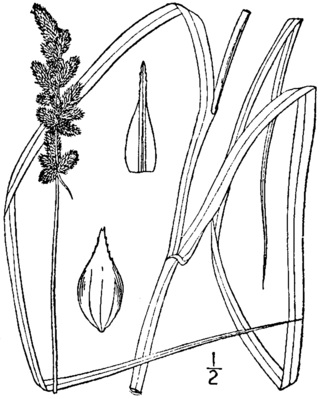
Carex annectens, sometimes called yellow-fruited fox sedge, is a species of sedge native to most of the eastern United States and southeastern Canada. It is common in prairies and high-water table fallow fields. In the Chicago area, its coefficient of conservatism is 3, and in Michigan, it is only 1, indicating its relatively low fidelity to high quality habitats.
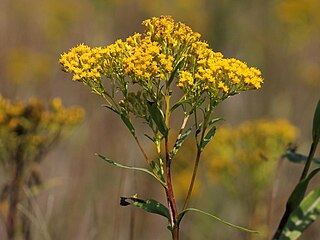
Solidago sect. Ptarmicoidei is a section of flowering plants in the genus Solidago. They are sometimes considered a separate genus: Oligoneuron. Like related species they are known as goldenrods. This section contains seven species of perennial herbs, all native to North America. They are distinguished from other goldenrods by their corymbiform flowerheads, which are flat or rounded in profile and about as broad as tall or broader, for which they are sometimes called flat-topped goldenrods.
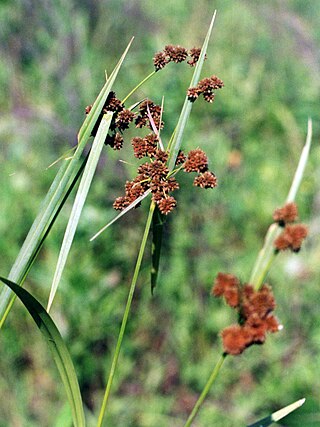
Scirpus atrovirens, known as dark-green bulrush, is a perennial sedge native to wetlands of eastern Canada and the United States. It is sometimes called dark green bulsedge, black bulrush, or green bulrush.

Carex lupulina, known as hop sedge or common hop sedge, is a species of sedge native to most of eastern North America.
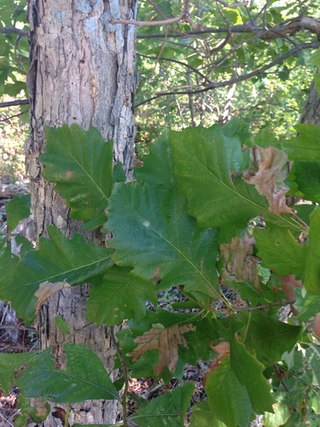
Quercus × deamii, known as Deam's oak, is a naturally occurring hybrid of chinquapin oak and burr oak. It occurs sporadically where their ranges overlap in the eastern United States and eastern Canada. It is named for self-taught botanist and state forester of Indiana Charles C. Deam, who had forwarded samples to William Trelease for description. They thought it to be a cross of Quercus alba and Q. muehlenbergii due to the large numbers of those trees growing in the vicinity. Many sources still reference Q. × deamii as a hybrid of the white oak and chinkapin oak.
References
- ↑ Kois, Barbara (15 November 1999). "Naturalist is a walking encyclopedia" . Daily Herald. Arlington Heights, Illinois . Retrieved 18 September 2018.
- 1 2 3 4 5 "Conservation Research Institute: Our Story". conservationresearchinstitute.org. Archived from the original on 14 October 2021. Retrieved 14 October 2021.
- ↑ Husar, John (7 April 1999). "The Great Unknown". chicagotribune.com. Chicago Tribune. Archived from the original on 19 January 2019. Retrieved 18 September 2018.
- 1 2 Journal of the Proceedings of the Forest Preserve District, Board of Commissioners of Cook County, Thursday, May 11, 2017 11:00 AM (PDF) (Report). Forest Preserve District of Cook County. 11 May 2017. Retrieved 18 September 2018.
- ↑ "New Book Catalogs Chicagoland Plants, Insect Interactions – Forest Preserves of Cook County". fpdcc.com. Forest Preserves of Cook County. 2 June 2017. Retrieved 18 September 2018.
- ↑ Hayda, Julian (11 April 2018). "Cook County's 'Next Century' Plan To Maintain Forest Preserves". WBEZ. Retrieved 18 September 2018.
- ↑ International Plant Names Index. Rericha.